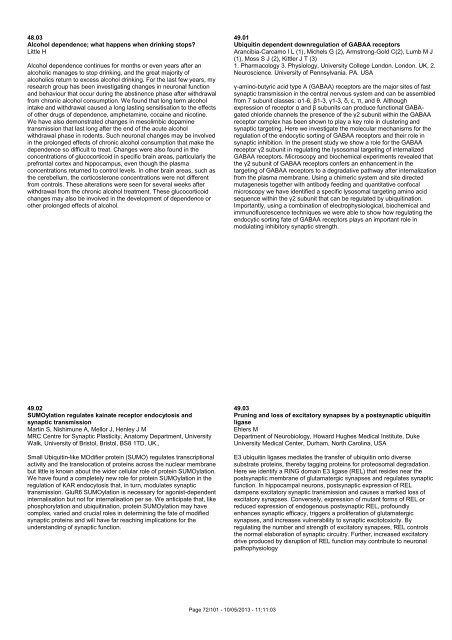Book of abstracts - British Neuroscience Association
Book of abstracts - British Neuroscience Association
Book of abstracts - British Neuroscience Association
Create successful ePaper yourself
Turn your PDF publications into a flip-book with our unique Google optimized e-Paper software.
48.03<br />
Alcohol dependence; what happens when drinking stops<br />
Little H<br />
Alcohol dependence continues for months or even years after an<br />
alcoholic manages to stop drinking, and the great majority <strong>of</strong><br />
alcoholics return to excess alcohol drinking. For the last few years, my<br />
research group has been investigating changes in neuronal function<br />
and behaviour that occur during the abstinence phase after withdrawal<br />
from chronic alcohol consumption. We found that long term alcohol<br />
intake and withdrawal caused a long lasting sensitisation to the effects<br />
<strong>of</strong> other drugs <strong>of</strong> dependence, amphetamine, cocaine and nicotine.<br />
We have also demonstrated changes in mesolimbic dopamine<br />
transmission that last long after the end <strong>of</strong> the acute alcohol<br />
withdrawal phase in rodents. Such neuronal changes may be involved<br />
in the prolonged effects <strong>of</strong> chronic alcohol consumption that make the<br />
dependence so difficult to treat. Changes were also found in the<br />
concentrations <strong>of</strong> glucocorticoid in specific brain areas, particularly the<br />
prefrontal cortex and hippocampus, even though the plasma<br />
concentrations returned to control levels. In other brain areas, such as<br />
the cerebellum, the corticosterone concentrations were not different<br />
from controls. These alterations were seen for several weeks after<br />
withdrawal from the chronic alcohol treatment. These glucocorticoid<br />
changes may also be involved in the development <strong>of</strong> dependence or<br />
other prolonged effects <strong>of</strong> alcohol.<br />
49.01<br />
Ubiquitin dependent downregulation <strong>of</strong> GABAA receptors<br />
Arancibia-Carcamo I L (1), Michels G (2), Armstrong-Gold C(2), Lumb M J<br />
(1), Moss S J (2), Kittler J T (3)<br />
1. Pharmacology 3. Physiology, University College London. London. UK, 2.<br />
<strong>Neuroscience</strong>. University <strong>of</strong> Pennsylvania. PA. USA<br />
γ-amino-butyric acid type A (GABAA) receptors are the major sites <strong>of</strong> fast<br />
synaptic transmission in the central nervous system and can be assembled<br />
from 7 subunit classes: α1-6, β1-3, γ1-3, δ, ε, π, and θ. Although<br />
expression <strong>of</strong> receptor α and β subunits can produce functional GABAgated<br />
chloride channels the presence <strong>of</strong> the γ2 subunit within the GABAA<br />
receptor complex has been shown to play a key role in clustering and<br />
synaptic targeting. Here we investigate the molecular mechanisms for the<br />
regulation <strong>of</strong> the endocytic sorting <strong>of</strong> GABAA receptors and their role in<br />
synaptic inhibition. In the present study we show a role for the GABAA<br />
receptor γ2 subunit in regulating the lysosomal targeting <strong>of</strong> internalized<br />
GABAA receptors. Microscopy and biochemical experiments revealed that<br />
the γ2 subunit <strong>of</strong> GABAA receptors confers an enhancement in the<br />
targeting <strong>of</strong> GABAA receptors to a degradative pathway after internalization<br />
from the plasma membrane. Using a chimeric system and site directed<br />
mutagenesis together with antibody feeding and quantitative confocal<br />
microscopy we have identified a specific lysosomal targeting amino acid<br />
sequence within the γ2 subunit that can be regulated by ubiquitination.<br />
Importantly, using a combination <strong>of</strong> electrophysiological, biochemical and<br />
immun<strong>of</strong>luorescence techniques we were able to show how regulating the<br />
endocytic sorting fate <strong>of</strong> GABAA receptors plays an important role in<br />
modulating inhibitory synaptic strength.<br />
49.02<br />
SUMOylation regulates kainate receptor endocytosis and<br />
synaptic transmission<br />
Martin S, Nishimune A, Mellor J, Henley J M<br />
MRC Centre for Synaptic Plasticity, Anatomy Department, University<br />
Walk, University <strong>of</strong> Bristol, Bristol, BS8 1TD, UK.,<br />
Small Ubiquitin-like MOdifier protein (SUMO) regulates transcriptional<br />
activity and the translocation <strong>of</strong> proteins across the nuclear membrane<br />
but little is known about the wider cellular role <strong>of</strong> protein SUMOylation.<br />
We have found a completely new role for protein SUMOylation in the<br />
regulation <strong>of</strong> KAR endocytosis that, in turn, modulates synaptic<br />
transmission. GluR6 SUMOylation is necessary for agonist-dependent<br />
internalisation but not for internalisation per se. We anticipate that, like<br />
phosphorylation and ubiquitination, protein SUMOylation may have<br />
complex, varied and crucial roles in determining the fate <strong>of</strong> modified<br />
synaptic proteins and will have far reaching implications for the<br />
understanding <strong>of</strong> synaptic function.<br />
49.03<br />
Pruning and loss <strong>of</strong> excitatory synapses by a postsynaptic ubiquitin<br />
ligase<br />
Ehlers M<br />
Department <strong>of</strong> Neurobiology, Howard Hughes Medical Institute, Duke<br />
University Medical Center, Durham, North Carolina, USA<br />
E3 ubiquitin ligases mediates the transfer <strong>of</strong> ubiquitin onto diverse<br />
substrate proteins, thereby tagging proteins for proteosomal degradation.<br />
Here we identify a RING domain E3 ligase (REL) that resides near the<br />
postsynaptic membrane <strong>of</strong> glutamatergic synapses and regulates synaptic<br />
function. In hippocampal neurons, postsynaptic expression <strong>of</strong> REL<br />
dampens excitatory synaptic transmission and causes a marked loss <strong>of</strong><br />
excitatory synapses. Conversely, expression <strong>of</strong> mutant forms <strong>of</strong> REL or<br />
reduced expression <strong>of</strong> endogenous postsynaptic REL, pr<strong>of</strong>oundly<br />
enhances synaptic efficacy, triggers a proliferation <strong>of</strong> glutamatergic<br />
synapses, and increases vulnerability to synaptic excitotoxicity. By<br />
regulating the number and strength <strong>of</strong> excitatory synapses, REL controls<br />
the normal elaboration <strong>of</strong> synaptic circuitry. Further, increased excitatory<br />
drive produced by disruption <strong>of</strong> REL function may contribute to neuronal<br />
pathophysiology<br />
Page 72/101 - 10/05/2013 - 11:11:03
















